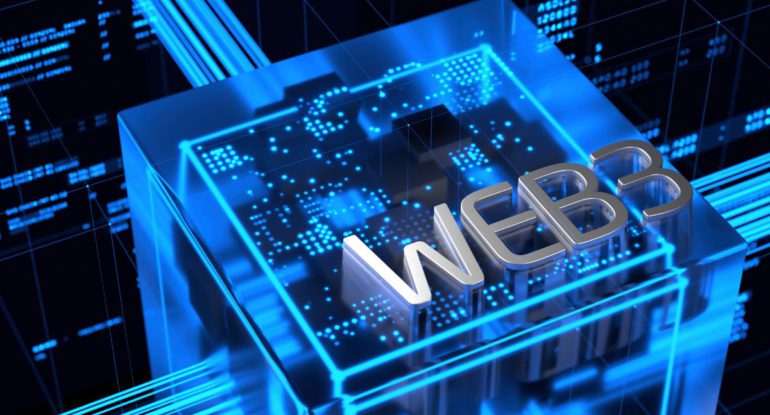Transforming Industries: How Web3 and Blockchain Will Reshape the Financial and IT World

The rise of Web3, propelled by the disruptive force of blockchain technology, is poised to revolutionize numerous industries. As businesses adapt to this paradigm shift, they must embrace the potential of decentralized systems and smart contracts. While this transformation presents both challenges and opportunities, its impact on the financial and IT world is particularly profound.
The Intricate Relationship Between Blockchain, Web3, and the IT World
The dynamic interplay between blockchain technology, Web3, and the IT world forms a powerful nexus that is reshaping industries, fostering innovation, and revolutionizing the way we interact with digital systems. Let’s delve into the intricate relationship between these elements, exploring their connections, impacts, and collaborative potential.
1. Blockchain Technology and its Role in the IT World
Blockchain Foundations: At its core, blockchain is a distributed and decentralized ledger technology. It records transactions across a network of computers, known as nodes, creating a chronological chain of blocks. Each block contains a list of transactions, linked in a way that ensures security, transparency, and immutability.
IT Integration: Blockchain’s integration into the IT world marks a paradigm shift. It introduces a novel approach to data management, offering a transparent, tamper-proof, and highly secure method for recording transactions and maintaining records. As the IT world grapples with data security concerns, blockchain presents an innovative solution.
2. Web3: The Evolution of the Web
Web3 Definition: Web3, often referred to as the “decentralized web,” signifies the next phase of internet evolution. It aims to transform the web from a centralized model (Web2) to a decentralized and user-centric ecosystem. Web3 envisions an internet where users have greater control over their data, identity, and interactions.
Blockchain Integration: Blockchain is a foundational pillar of Web3. It empowers users with digital sovereignty and control over their data through decentralized identity solutions and secure authentication mechanisms. Blockchain’s immutable nature enhances the verifiability and credibility of online interactions, aligning with Web3’s vision of trust and autonomy.
3. The Mutual Impact on the IT World
a. Disrupting Data Management: Blockchain introduces a revolutionary approach to data management and security. Its decentralized nature reduces the reliance on centralized servers susceptible to breaches. IT professionals must adapt their data management strategies to incorporate blockchain’s tamper-proof, distributed ledger model.
b. Enhanced Security Measures: Blockchain’s cryptographic techniques enhance data security, guarding against unauthorized access and tampering. This necessitates the IT world to rethink cybersecurity practices, explore encryption mechanisms, and leverage blockchain for robust security solutions.
c. Smart Contracts and Automation: Smart contracts, self-executing code executed on the blockchain, automate processes and transactions. IT professionals can utilize these contracts to streamline operations, reduce manual intervention, and enhance efficiency in various sectors, from supply chain management to financial services.
d. Decentralized Applications (DApps): Web3’s emphasis on decentralization has led to the emergence of DApps—applications built on blockchain platforms. These DApps offer users greater privacy, control, and data ownership. IT developers can harness blockchain’s capabilities to create innovative DApps that reshape user experiences.
4. Industries Impacted by the Triad
a. Financial Services: Blockchain’s role in revolutionizing financial systems and the rise of DeFi exemplify its profound impact on the sector. Smart contracts enable seamless cross-border transactions and programmable financial instruments, reshaping banking and payments.
b. Supply Chain Management: Blockchain’s transparency and traceability empower supply chains to enhance accountability, reduce fraud, and ensure product authenticity. The IT world contributes by designing blockchain-based solutions that optimize supply chain operations.
c. Healthcare: Blockchain’s data security and interoperability capabilities improve patient data management, medical record sharing, and drug traceability. The IT world plays a pivotal role in developing blockchain-powered healthcare applications.
d. Identity Verification: Web3’s emphasis on user-controlled identities and blockchain’s secure authentication mechanisms converge to redefine identity verification in the digital age. The IT world is pivotal in developing user-friendly, secure identity solutions.
The intricate relationship between blockchain, Web3, and the IT world is one of symbiotic innovation. Blockchain’s transformative potential is harnessed by Web3 to create a user-centric internet ecosystem. Meanwhile, the IT world is the driving force behind the implementation, development, and adaptation of these technologies. As blockchain and Web3 continue to evolve, their impact on the IT landscape will grow, necessitating a flexible and adaptive approach to embrace their potential and shape the digital future.
Also, read – Top Ten Blockchain & Web3 Enterprise Development Services in 2022
Financial Services in the Age of Web3
Blockchain technology has ignited a series of transformative trends in the financial landscape:
1. DeFi (Decentralized Finance)
DeFi represents a groundbreaking financial system built on blockchain’s foundations. This web-native structure eliminates the need for intermediaries by utilizing smart contracts and blockchains to facilitate peer-to-peer transactions. The potential for increased efficiency and accessibility is immense, with the traditional role of centralized banks poised for disruption.
1. Accessibility: Defi ATMs enable access to decentralized finance services for individuals who may not have access to traditional banking systems. They provide a user-friendly interface for anyone with an internet connection to interact with various financial services.
— Velorex | DeFi ATM | Web3 (@VelorexOfficial) August 5, 2023
2. Digital Assets and NFTs
Cryptocurrency and Non-Fungible Tokens (NFTs) have ushered in a new era of digital assets. Financial institutions must consider the integration of web3 assets alongside traditional portfolios, opening avenues for innovative approaches to asset and wealth management.

3. Regenerative Finance (ReFi)
The intersection of web3, blockchain, and climate action is giving rise to ReFi. This concept seeks to align investments with environmental sustainability by leveraging blockchain’s transparent verification mechanisms. It allows investors to support organizations committed to preserving natural resources and combating climate change.
4. Blockchain-Based Lending and Money Transfer Networks
Web3 technology has facilitated peer-to-peer lending through smart contracts, simplifying the lending process while reducing intermediaries. Additionally, platforms like Ripple’s blockchain-based money transfer network have streamlined cross-currency transactions with enhanced speed and lower fees.
The IT Revolution: Decentralized Data and Networking
1. Decentralized Data Storage
Web3 is transforming data storage models, replacing centralized approaches with peer-to-peer storage networks. Users can rent storage space or monetize their excess storage capacity, offering heightened security and data preservation compared to traditional centralized systems.
2. Blockchain-Based Networks
Projects like Helium exemplify the decentralized networking revolution. These platforms empower users to build a network collectively, disrupting the traditional models of telecom companies and internet service providers.
Expanding Impact Across Industries
The influence of Web3 extends beyond the financial and IT sectors:
1. Architecture in the Metaverse
Architects are embracing the metaverse, designing structures that exist in this immersive digital realm. This shift requires innovative approaches to design and construction, merging virtual and physical environments seamlessly.
2. Smart Contracts and Legal Advice
Law firms are navigating the complexities of the metaverse, providing legal counsel on contracts, property rights, and intellectual property within digital domains.

3. Real Estate and Immersive Marketing
Real estate agents are leveraging the metaverse to market properties. Immersive property tours, virtual staging, and even virtual real estate sales in the metaverse are redefining the industry’s landscape.
4. Embracing Innovation Across Professions
Every industry will feel the ripple effects of web3 and the metaverse. Accountants can integrate smart contracts for client payments, HR professionals can onboard remote talent within a metaverse environment, and insurance firms can enhance their offerings through smart contracts.
Conclusion
Web3’s ascent ushers in a new era of possibilities and challenges across industries. Financial services and IT sectors are undergoing transformative shifts as blockchain and decentralized systems redefine operations. The metaverse’s influence is seeping into architecture, law, real estate, and beyond. Successful adaptation requires a proactive approach—embracing innovation, minimizing threats, and capitalizing on opportunities. With knowledge and readiness, businesses and professionals can harness the potential of the future internet to navigate a landscape forever transformed.




























































